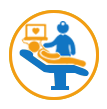Mr. Binode's amazing recovery
A stroke left Mr.Binode with hemiparesis, tremendously weakening his left side. When flown in by an air ambulance at ApoKOS, he was bedridden having lost his ability to walk, produce speech or engage in daily activities. With bed exercises and chest therapy, efforts to return Mr Goswami to his regular life kicked off. After satisfactory results from initial therapies, he moved on to achieve his next set of goals like dynamic sitting and standing up. After 5 months of rehabilitative care and determination, he has achieved most of his goals, including standing up, walking with a walker and speak.
PATIENT DETAILS
Who is a candidate for Neurological Rehabilitation?
TIA occurs when the blood flow to a part of the brain is interrupted for a short period of time. Though TIA usually does not cause acute cell death in the brain, it exhibits symptoms similar to that of a stroke attack which can last for a period of 24 hours. The challenges pertaining to recovery may not be as severe as those of stroke patients but TIA needs to be managed successfully as it can be a warning of an impending stroke attack. A comprehensive rehabilitation program caters to both managing the present challenges as well as the risks of a future stroke.
Damage sustained to the spinal cord can alter the physical functioning of the patient temporarily or permanently. SCIs are classified as complete or incomplete spinal cord injuries, with complete SCI severely compromising all functions below the region of injury. In the case of incomplete SCI, the patient may still retain some motor and sensory functions below the spot of injury. SCI rehabilitation is a multidisciplinary program which entails experts from different disciplines, such as physiotherapy and occupational therapy,providing care to the patient at each progressive stage of rehabilitation to help the patient get back to their normal life. Another vital component of the patient’s well-being is ensuring them emotional support through continuous counselling during the course of the rehabilitation care.. Read more
Traumatic brain injuries are caused by external trauma or force exerted on the skull which can violently move around the brain inside the cranium. For the continued recovery of the patient after acute-care phase, an integrated and comprehensive rehabilitation program addressing the challenges and goals of the patient is always advisable. Depending on the level of disability experienced, patients are provided with rehabilitative care to enhance function and recover strength and movement in the muscles, with the goal of enabling them to engage in everyday activities with maximum independence.. Read more
Patients develop impairments or deficits as a direct effect of the tumor itself or due to the surgical or chemo treatment they undergo. Therefore after the acute care phase rehabilitative care becomes a necessity for a patient’s overall recovery. Rehabilitation entails speech therapy for correcting speech and swallow disorders, physiotherapy for strength building and improving mobility in the limbs and occupational therapy for enhancing function to engage in everyday activities. Patients may also require Cognitive Behaviour Therapy for adequate psychological support to cope with their changed circumstances.
Patients develop impairments or deficits as a direct effect of the tumor itself or due to the surgical or chemo treatment they undergo. Therefore after the acute care phase rehabilitative care becomes a necessity for a patient’s overall recovery. Rehabilitation entails speech therapy for correcting speech and swallow disorders, physiotherapy for strength building and improving mobility in the limbs and occupational therapy for enhancing function to engage in everyday activities. Patients may also require Cognitive Behaviour Therapy for adequate psychological support to cope with their changed circumstances.. Read more
GBS is characterized by the breakdown of myelin insulation of the nerves by the immune system. This in turn leads to neuromuscular weakness and associated disabilities in the patient. The patient might initially experience a tingling sensation or weakness in the legs, which can evolve into paralysis or hemi-paresis as the condition worsens. Since GBS induces neuromuscular weakness, the patient can also experience difficulty breathing.
Rehabilitative care for GBS has been found to be effective in returning functions to the patient. As the severity of the condition and the impairments experienced will be different from individual to individual, rehabilitative care for GBS entails a very personalized prognosis and rehab strategy. The prognosis can demand an integrated rehab plan with different experts like physiotherapists, speech therapists, pain management and medical management experts tending to the patient with the goal of returning them to life with maximum independence.
While head injuries are the main cause of Subdural Hematoma, patients with existing bleeding orders are the most prone to developing the condition. Subdural Hematoma can leave a patient with disabilities such as speech and swallow impairments and weakness in the limbs. An integrated rehabilitation program can aid patients return to normal daily activities.
Parkinson’s disease affects the nervous system, rendering motor functions difficult. Parkinson’s is a degenerative disease whose symptoms worsen with time but today treatment is available in the form of medications, brain stimulation along with rehabilitative techniques to abate its progression in a patient. Targeted rehabilitative treatment can benefit the patient in terms of improvement in flexibility, mobility, gait speed and strength. In addition, with effective rehabilitation, patients can exhibit improvements in regards to functions and fall risk.
Alzheimer’s is a neurodegenerative disease that affects the patient’s mood, memory, neuro-motor skills and other bodily functions. Since different symptoms become more pronounced in different patients, rehabilitation program begins with a thorough assessment of the patient’s status and the progression of the disease. Physiotherapy concentrates on retaining muscle strength and movement while speech and swallow therapy focuses on deficits related to speech production and nutrition intake.
Amyotrophic Lateral Sclerosis (ALS) is a motor neurone disease which is characterized by the death of neurons which control voluntary muscles. Common symptoms of the disease therefore include difficulty in speaking, swallowing, breathing, and restricted muscle movements. But rehabilitative care can make a huge impact on patients with ALS enabling them to adapt with their changed circumstances and preserve as much independence as possible. Physical therapy focuses on retaining strength, endurance and energy conservation while Occupational therapy can help patients engage in everyday activities and help choose a suitable assistive device for enhanced safety and independence. Speech and swallow therapist can help the patient overcome challenges in communication as well as swallowing.
Comprehensive Neuro treatment
Throughout the patient’s stay at our facility, our trained nurses take care of the medical needs of the patient. They also ensure that the treatment continues as per plan by coordinating with the various team members and through regular feedback from the patient and family.
Our neurological rehabilitation program offers seven salient features

Comprehensive
We aim at physical, psychological, cognitive, cultural and social aspects of the patients’ personalities, their stage of recovery and their own and their family’s lifestyle.

Patient-centric
We customize our healthcare strategies according to the patients and their families for the patient is at the centre of our entire rehabilitation process

Integrated
We design and follow a multidisciplinary approach which includes expert and motivated care personnels experienced in working in a team structure.

Inclusive
We believe in the power of family support for the patient’s optimum rehabilitation so we encourage the family’s active participation and cooperation in the recovery process.

Empowering
We want our patients to be as independent as possible so we try to empower them and build their confidence by reducing increased dependence on mobility aids.

Continuous
We provide all possible human and material resources to tackle each and every problem of the patient as and when they arise to help them achieve the highest level of recovery and independence.

Committed
We know that a patient needing neurological rehabilitation might develop several new complications with age, so we offer out-patient rehabilitation to keep track of their life-long progress.


